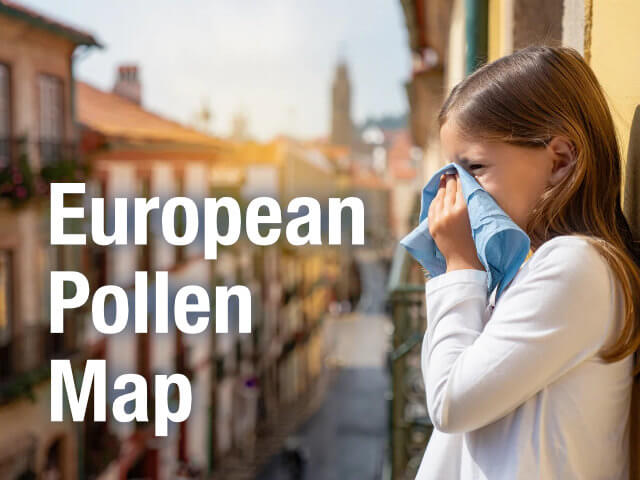European Pollen Map
Explore daily pollen levels across Europe with our interactive pollen map. Select specific pollen types below to see current concentrations and help manage your allergy symptoms effectively. Updated daily from over 100 monitoring stations.
- Alder
- Birch
- Grass
- Mugwort
- Olive
- Ragweed
Set up Pollen Alerts to get notified when pollen levels peak in your city 🤧🌿

You can select any of the main pollen types to see the current situation in Europe based on our sample data. This feature helps allergy sufferers stay informed and plan accordingly.
Understanding Pollen Maps
Our pollen count map visualizes the concentration of airborne pollen particles, helping those with allergies anticipate symptoms and take preventive measures.
The allergy map Europe aggregates data from multiple countries, including the pollen map UK, pollen map Netherlands, and regional monitoring stations.
For broader European forecasts, services like the Copernicus Atmosphere Monitoring Service (CAMS) provide official pollen outlooks.
Our pollen maps track all major allergens including tree pollen map data, grass pollen map information, and weed pollen like our specialized ragweed map.
The development of Europe-wide automatic monitoring networks, such as the EUMETNET AutoPollen programme, aims to further improve the accuracy and timeliness of such data.
For travelers and locals alike, checking the pollen map today gives crucial information about current exposure risks.
The allergy weather map also considers meteorological conditions that affect pollen dispersion, making it an essential tool for hayfever sufferers across Europe.
Our Changing Climate
It's important to note that climate change is impacting pollen seasons and intensity across Europe. You can learn more about these effects on aeroallergens from the European Environment Agency (EEA).
Major Pollen Types in Europe
-
Tree Pollen
Our current tree pollen map shows common allergens like birch pollen map data and other tree species. The tree pollen map is especially important in early spring when forests and urban parks begin pollinating. In the UK pollen map, tree pollen appears earliest in southern regions.
Peak Season: February to May
-
Grass Pollen
The grass pollen map affects the largest number of allergy sufferers in Europe. Our pollen levels map for grass species shows varying intensities across different regions, with the pollen concentration map updated daily for accuracy.
Peak Season: May to July
-
Weed Pollen
Our ragweed allergy map and other weed pollen tracking systems monitor plants like mugwort across Europe. The ragweed map is particularly important for Eastern and Central European regions where this highly allergenic plant is spreading rapidly.
Peak Season: July to October
Pollen Types We Track
Our interactive map allows you to view levels for major allergenic pollen types across Europe. Select a type above the map to see its current distribution. For detailed information on specific allergies, please visit:
Regional Pollen Maps
Our comprehensive allergy map covers numerous European regions with specialized focus:
- UK and London: The pollen count today UK map and pollen map London provide specific data for British allergy sufferers, with the UK pollen map updated daily.
- Netherlands: Our pollen map Netherlands focuses on the unique flora of this densely populated region.
- Mediterranean: Track olive and cypress pollen in Spain, Italy and other southern European countries.
- Central Europe: Monitor birch, grass, and the increasing presence of ragweed in Germany, Poland and Hungary.
How to Use Our Pollen Tracker
Our interactive pollen allergy map provides once-daily updates on pollen concentrations across Europe. Select your allergen of interest from the options above the pollen map to view today's levels. For those with hayfever, the color-coded national allergy map shows intensity levels with darker colors representing higher concentrations.
The mapa de polen (pollen map) includes data from over 100 monitoring stations, making it one of the most comprehensive allergies map resources available. Whether you're checking the pollen map today for your local area or planning travel, our pollen maps offer valuable insights for managing your symptoms.
Managing Pollen Allergies
Regular monitoring of our allergy weather map can significantly improve quality of life for allergy sufferers. Consider these strategies during high pollen periods.
For more detailed medical information and resources, you can visit the EAACI patient portal on pollen allergies and follow these guidelines:
- Keep windows closed during peak pollen hours (typically early morning and early evening)
- Shower and change clothes after spending time outdoors
- Use air purifiers with HEPA filters indoors
- Consult with healthcare providers about appropriate medications
- Plan outdoor activities when pollen counts are lower on the pollen concentration map